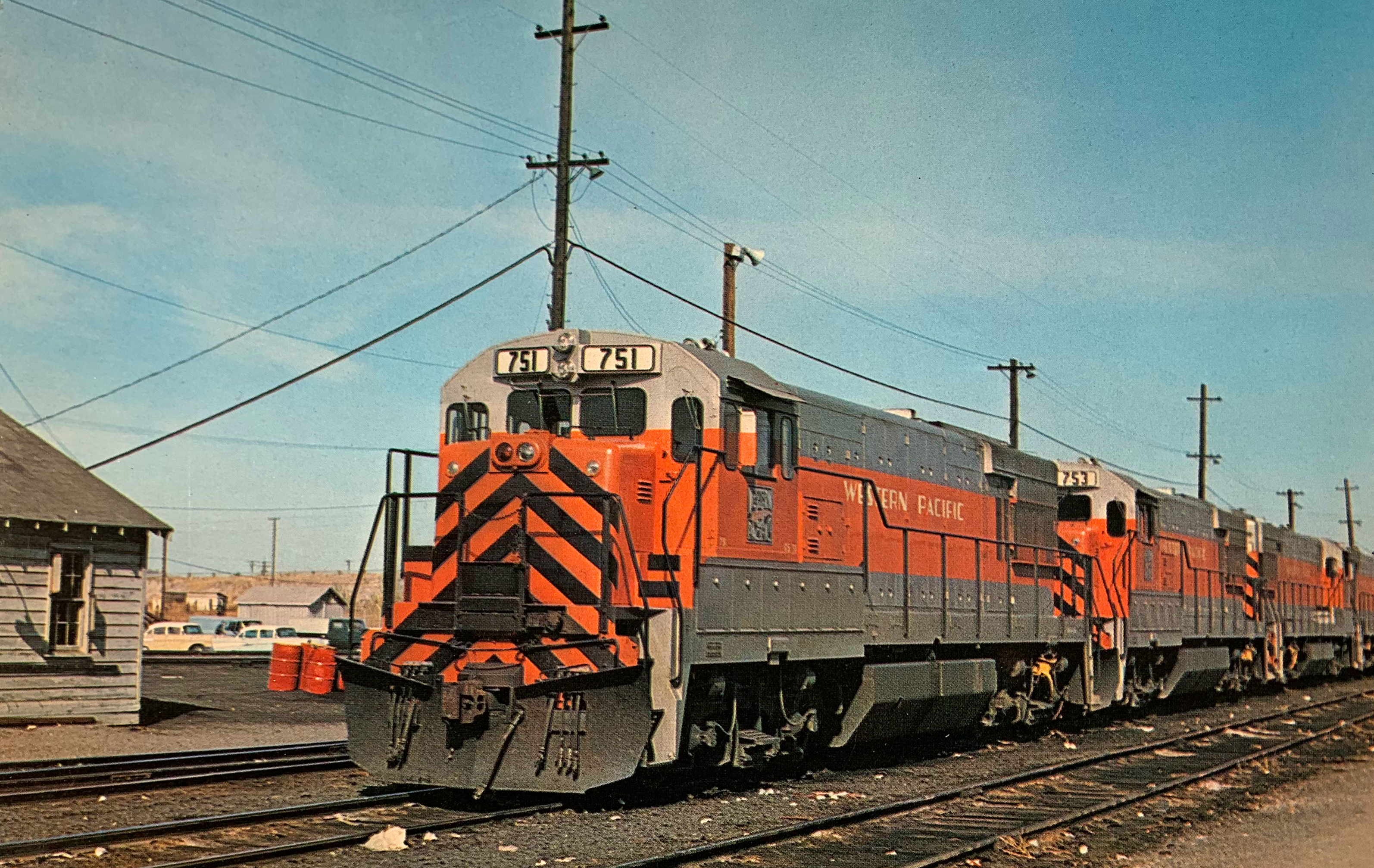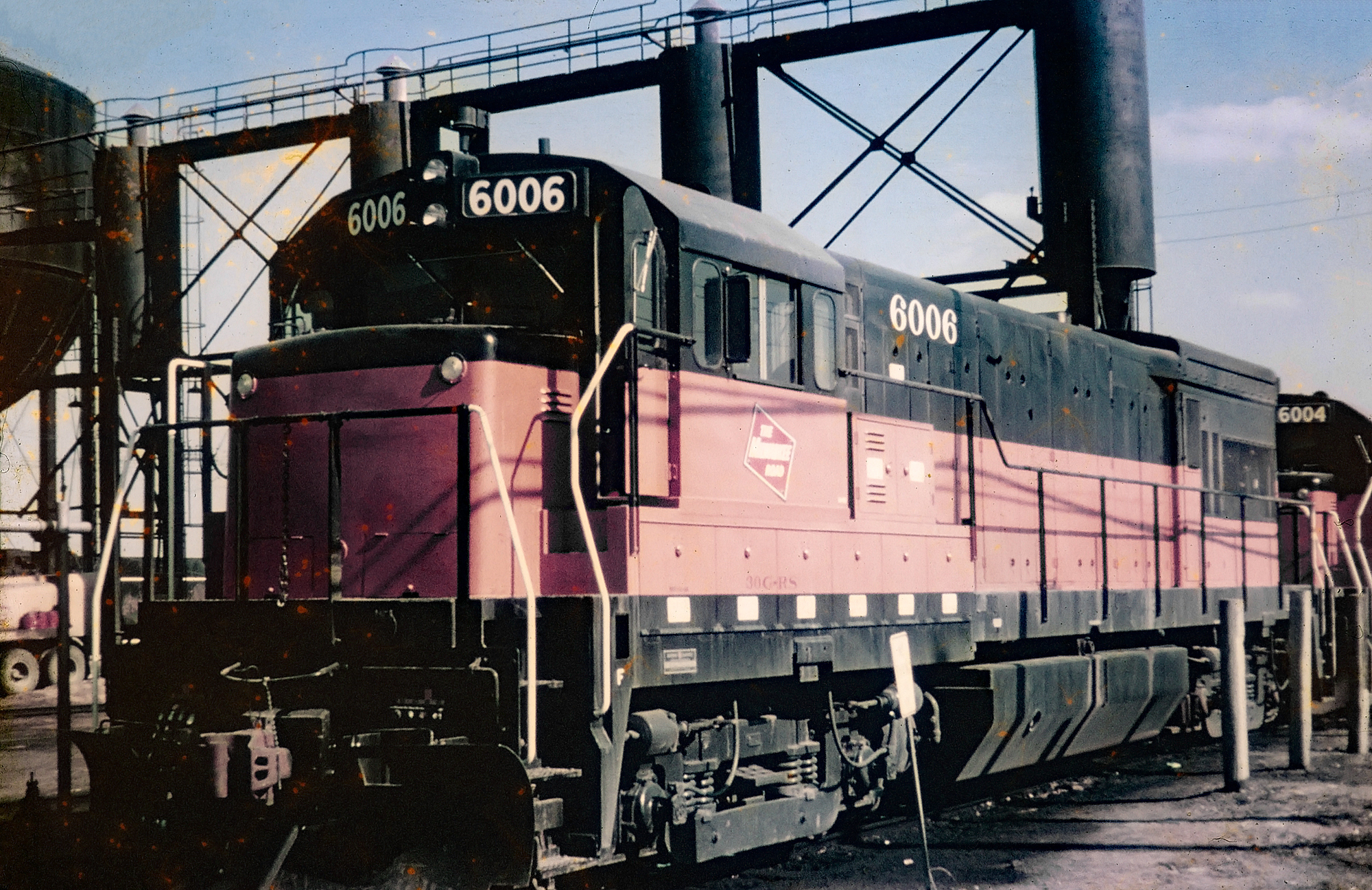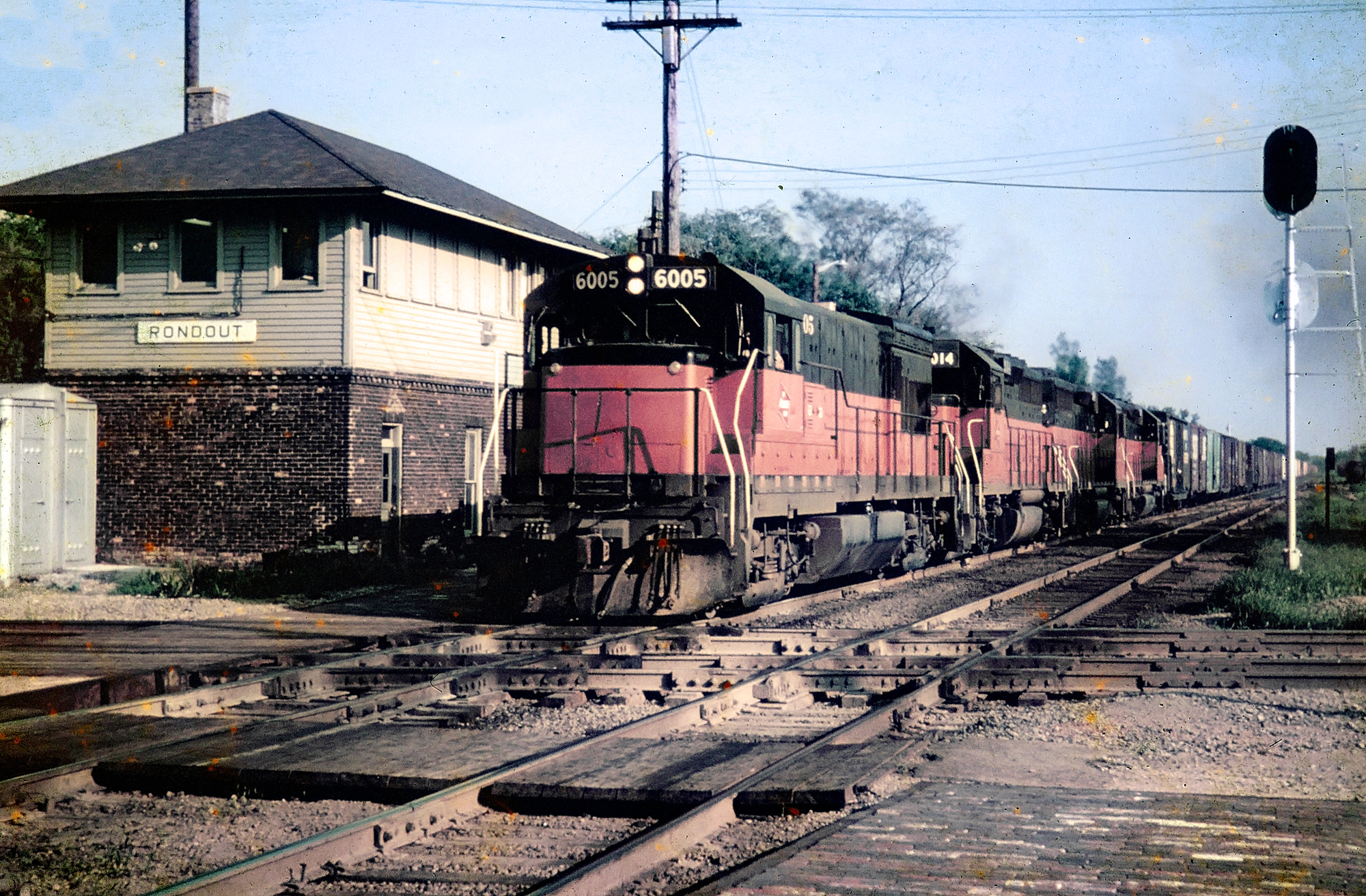GE "U30B" Locomotives: Specs, Roster, History
Last revised: January 10, 2025
By: Adam Burns
In many ways, the U30B was a milestone locomotive, allowing General Electric to finally offer a 3,000 horsepower road-switcher under a single hood.
During the horsepower race of the 1960's, all three builders worked towards, and finally achieved, a 3,000 horsepower variant.
The U30B witnessed modest sales (295 units) as the industry began recognizing the benefits of six-motored, high-horsepower locomotives.
GE locomotives continued to grow in popularity thanks to the builder's dedication to its product. However, most crews never liked the U-boat, complaining of their rough ride and reliability.
The U30B featured a number of upgrades during its production run, a trait that continued throughout the Universal line and into the later "Dash 7" line.
Today, there are at least two U30Bs preserved; Burlington Northern #5789 at the Orrville Railroad Heritage Society in Ohio and Western Pacific #751 at the Western Pacific Railroad Museum in Portola, California.
Photos
 A group of new Western Pacific U30B's, just a little over a month old, layover at the Rio Grande's Roper Yard in Salt Lake City, Utah on October 27, 1967. C.G. Heimerdinger, Jr. photo. Author's collection.
A group of new Western Pacific U30B's, just a little over a month old, layover at the Rio Grande's Roper Yard in Salt Lake City, Utah on October 27, 1967. C.G. Heimerdinger, Jr. photo. Author's collection.Overview
The U30B began production in May, 1966. General Electric's introduction of its 3,000 horsepower road-switcher was largely without fanfare.
As Greg McDonnell notes in his book "U-boats," demonstrators #301-304 rolled out of Erie, Pennsylvania quietly that spring and began testing on the New York Central.
There were almost no noteworthy features on the locomotives to distinguish them from any other U-boat; they were adorned in a solid black scheme with a small GE logo under the cab window.
 Milwaukee Road U30B's #6006 and #6004 are serviced at the engine terminal in Bensenville, Illinois in April, 1968. Fred Byerly photo. American-Rails.com collection.
Milwaukee Road U30B's #6006 and #6004 are serviced at the engine terminal in Bensenville, Illinois in April, 1968. Fred Byerly photo. American-Rails.com collection.The U30B also represented General Electric's efforts to play catchup as Alco and Electro-Motive had already released their own 3,000 horsepower units.
In his book, "GE Locomotives," Brian Solomon notes how GE was able to finally achieve a stand-alone 3,000 horsepower road-switcher; the AC-DC transmission system.
The company's 7FDL16 prime mover was already capable of producing the needed horsepower. The problem was in transferring this power to the traction motors and axles where it could be utilized.
 Milwaukee Road U30B #6005 leads a long freight westbound/northbound over the Elgin, Joliet & Eastern diamonds at Rondout, Illinois during June, 1968. Fred Byerly photo. American-Rails.com collection.
Milwaukee Road U30B #6005 leads a long freight westbound/northbound over the Elgin, Joliet & Eastern diamonds at Rondout, Illinois during June, 1968. Fred Byerly photo. American-Rails.com collection.Solomon notes: "The new system used an alternator rather than a generator and employed silicon diodes to rectify alternating current to the direct current needed by traction motors.
This reduced the number of components, decreased maintenance, and, most significantly, allowed for higher output to traction motors."
Reception
For General Electric the soft sales of the four-axle U30B, and particularly with the two latter models (the U33B and U36B), was a sign that B-B main line locomotives were losing demand within the industry.
Understanding this, General Electric instead began to focus more heavily on six-axle designs by the early 1970s.
Its late model C-Cs like the U30C, U33C, and U36C sold quite well for the company as more than 1,000 were produced. It was just a start but soon EMD would have serious competition by the early 1980s.
Data Sheet and Specifications
| Entered Production | 5/1966 (GE Demonstrators #301-302) |
| Years Produced | 5/1966 - 3/1975 |
| GE Class | U30B |
| Engine | 7FDL16 (16 cylinder) |
| Engine Builder | General Electric |
| Horsepower | 3000 |
| RPM | 1050 |
| Length | 60' 2" |
| Height (Top Of Rail To Top Of Cab) | 14' 9" |
| Width | 9' 11" |
| Weight | 254,800 Lbs |
| Fuel Capacity | 1,700 or 2,900 Gallons |
| Air Compressor | 3CDC (Westinghouse) |
| Air Brake Schedule | 26NL (Westinghouse) |
| Trucks | B-B |
| Truck Type | Swing Bolster, Drop-Side Equalizer (GSC) or Floating Bolster FB2 (GE) |
| Truck Wheelbase | 9' 4" |
| Wheel Size | 40" |
| Traction Motors | 752 (4), GE |
| Traction Alternator | GTA-11AC, GE |
| Auxiliary Generator | GY27, GE |
| MU (Multiple-Unit) | Yes |
| Dynamic Brakes | Optional |
| Gear Ratio | 74:18 |
| Tractive Effort (Starting) | 70,000 Lbs |
| Tractive Effort (Continuous) | 64,000 Lbs at 10.7 mph |
| Top Speed | 70 mph |
Production Roster
| Owner | Road Number | Serial Number | Order Number | Completion Date | Quantity |
|---|---|---|---|---|---|
| General Electric (Demonstrator) | 301-302* | 35880-35881 | 9005 | 5/1966 | 2 |
| General Electric (Demonstrator) | 303-304** | 35935-35936 | 1424 | 6/1966 | 2 |
| Seaboard Air Line | 800-814*** | 36121-36135 | 1548 | 12/1966-1/1967 | 15 |
| Atlantic Coast Line | 975-978 | 36144-36147 | 1546 | 1/1967 | 4 |
| Illinois Central | 5000-5005 | 36200-36205 | 1554 | 2/1967-3/1967 | 6 |
| New York Central | 2830-2839 | 36246-36255 | 1552 | 11/1966-2/1967 | 10 |
| Norfolk & Western | 1930-1944**** | 36256-36270 | 1555 | 3/1967-5/1967 | 15 |
| Norfolk & Western | 1945-1956**** | 36326-36337 | 1573 | 6/1967 | 12 |
| Norfolk & Western | 1962-1964**** | 36338-36340 | 1573 | 7/1967 | 3 |
| Norfolk & Western | 1960-1961**** | 36341-36342 | 1573 | 7/1967 | 2 |
| Norfolk & Western | 1957-1959**** | 36343-36345 | 1573 | 7/1967 | 3 |
| New York Central | 2840-2857 | 36379-36396 | 1575 | 7/1967-9/1967 | 18 |
| New York Central | 2860-2889 | 36411-36440 | 1577/1588 | 7/1967-9/1967 | 30 |
| Louisville & Nashville | 2505-2509 | 36443-36447 | 1589 | 11/1967 | 5 |
| Milwaukee Road | 6009 | 36449 | 1584 | 1/1968 | 1 |
| Western Pacific***** | 751-755 | 36451-36455 | 1587 | 9/1967 | 5 |
| Milwaukee Road | 6005-6008 | 36500-36503 | 1584 | 1/1968 | 4 |
| Chicago, Burlington & Quincy | 150-154 | 36520-36524 | 1583 | 1/1968 | 5 |
| Western Pacific***** | 756-759 | 36833-36836 | 1404 | 9/1968 | 4 |
| St. Louis-San Francisco Railway (Frisco) | 832-835 | 36850-36853 | 1406 | 10/1968-11/1968 | 4 |
| Western Pacific***** | 760-769 | 36998-36707 | 1435 | 4/1969-5/1969 | 10 |
| St. Louis-San Francisco Railway (Frisco) | 836-843 | 37164-37171 | 1453 | 8/1969-9/1969 | 8 |
| Norfolk & Western | 8465-8514*** | 37441-37490 | 1454 | 8/1970-1/1971 | 50 |
| Norfolk & Western | 8515-8539*** | 37747-37771 | 1462 | 5/1971-11/1971 | 25 |
| Chesapeake & Ohio | 8200-8209 | 38218-38227 | 1471 | 12/1971-1/1972 | 10 |
| Chesapeake & Ohio | 8210-8222 | 38475-38487 | 1482 | 11/1972-12/1972 | 13 |
| St. Louis-San Francisco Railway (Frisco) | 854-857 | 39901-39904 | 1435 | 8/1974-9/1974 | 4 |
| St. Louis-San Francisco Railway (Frisco) | 844-853 | 39928-39937 | 2578 | 5/1973 | 10 |
| Chesapeake & Ohio | 8225-8234****** | 40068-40077 | 1446 | 12/1974 | 10 |
| St. Louis-San Francisco Railway (Frisco) | 858-862 | 40257-40261 | 1471 | 3/1975 | 5 |
* Became Chesapeake & Ohio #8223-8224.
** Became Western Pacific #770-771; equipped with Blomberg trucks.
*** Equipped with Blomberg trucks from trade-in F3's.
**** Equipped with a high, short hood.
***** Equipped with Blomberg trucks.
****** Equipped with General Electric's new floating bolster "FB2" truck, released in 1974.
XR Series
During the course of production the U30B enjoyed several improvements, most notably the rear radiator whereby GE began "flaring" the compartment a few inches wider than the carbody.
This became a notable trait of GE locomotives that carries on today under GE successor Wabtec Freight. The U30B was also the first too feature GE's new "XR Series" of 1972, which stood for Extra Reliability.
The series featured more than 50 upgrades to the U-boat line such as improved wiring, insulation, wheel slip controls, and more. There were even a few locomotives to sport a special "XR" livery including Louisville & Nashville U30C #1409 and St. Louis-San Francisco U30B #846.
Sources
- Foster, Gerald. A Field Guide To Trains. New York: Houghton Mifflin, 1996.
- Marre, Louis A. Diesel Locomotives: The First 50 Years, A Guide To Diesels Built Before 1972. Milwaukee: Kalmbach Publishing Company, 1995.
- McDonnell, Greg. U-boats. Toronto: Stoddart Publishing, 1994.
- Pinkepank, Jerry A. Diesel Spotter's Guide. Milwaukee: Kalmbach Publishing Company, 1967.
- Solomon, Brian. GE Locomotives: 110 Years Of General Electric Motive Power. St. Paul: MBI Publishing, 2003.
Recent Articles
-
Rio Grande 2-8-2 Locomotives (Class K-28): Specs, Roster, Photos
Apr 14, 25 10:24 PM
Rio Grande's Class K-28 Mikados were its newest narrow-gauge steam locomotives since the Mudhens of the early 1900s. Today, three survive. -
Rio Grande K-27 "Mudhens" (2-8-2): Specs, Roster, Photos
Apr 14, 25 05:40 PM
Rio Grande's Class K-27 of 2-8-2s were more commonly referred to as Mudhens by crews. They were the first to enter service and today two survive. -
C&O 2-10-4 Locomotives: Specs, Roster, Photos
Apr 13, 25 04:07 PM
Chesapeake & Ohio's T-1s included a fleet of forty 2-10-4 "Texas Types" that the railroad used in heavy freight service. None were preserved.


